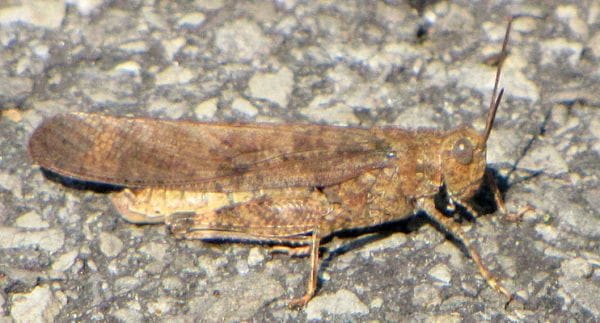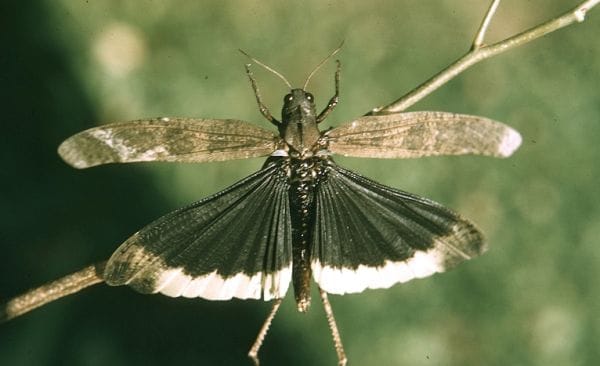When I was a child, we called them locusts. They appeared sometime between when we started to worry about the water level in the well and when we started to worry about going back to school. They were huge – well, huge for grasshoppers, anyway – and dust-colored, and they jumped like gunpowder-propelled novelties out of my way as I walked any sunny, dry path. Their wings were huge and attention-getting, bigger than the cabbage whites and sulfur butterflies, black with a yellow edge that started bright and faded with the summer, and they whirred as they flew. And there were so, so many of them. Everywhere I went outside, dozens, scores. Hundreds, if I had wanted them, but I didn’t really. They consistently disappointed me by not being butterflies or small birds, and I associated them with an oppressive sun and being a long way from the garden hose and getting a headache for want of a drink.
It wasn’t until I noticed the “locusts” here in Montana that I got curious about them. Surely they couldn’t be the same species, across a continent. But they are. The Carolina grasshopper Dissosteira carolina ranges from sea to shining sea, into Canada and nearly to the tip of Texas. Wherever they roam, they prefer weedy grasslands with areas of bare dirt where they can sun themselves. Human-created habitats like road edges, pastures, and railroad right-of-ways suit them to a tee, so it hardly seems fair to call them the locusts when we are the ones who have expanded explosively and stripped the land bare.
Philosophy aside, I wondered about their role in the grand scheme of things. Unlike proper locusts they do not change morphologically in response to crowding, nor do they form vast traveling swarms. Populations may irrupt in favorable years in favorable habitat, but for the most part their population densities are moderate in grasshopper terms. Their great conspicuousness – the affinity for roads and paths, the startling wings leaping out of camouflage, the noise and the size – may make them seem more common than they are.
Boo!
The Internet was prepared to offer plenty of information on what Carolina grasshoppers eat – grasses and forbs, mostly weed species but sometimes crops like tobacco,corn, and alfalfa. Far scarcer are specifics on what eats Carolina grasshoppers. Surely these big meaty hoppers – males weigh an average of 570 mg as adults, females more than twice as much – are a bounty to someone. But who?* “Birds”, says the all-knowing Internet. Thanks a lot, Internet. That’s real helpful.
So, which birds? The American Kestrel seems like a safe bet – it too favors roadsides and field edges, it’s the right size, its keen eyes would allow it to pick out the hidden sitting grasshoppers and its swift falcon wings would let it pursue the flying ones. The Swainson’s Hawk is called Grasshopper Hawk for a reason. Cattle Egrets might well get them when they leap out of the way of our domestic replacement bison. Large flycatchers might take them too, when they are flushed – their flights often extend 10 feet or more. Given the time of year they emerge, I can’t help but suspect that they’re very valuable to the just-fledged young and about-to-migrate adults of the species that prey on them – not plague at all but manna, depending on how you look at it.
Dear readers, spill – have you ever seen birds preying on Carolina grasshoppers, and if so, what species?
*note: if you decide to snack on Carolina grasshoppers, or any other grasshoppers, be sure to cook them thoroughly. They can carry parasites to humans.
Sitting grasshopper photo courtesy of D. Gordon E. Roberston
Flying grasshopper photo courtesy of Edward L. Manigault, Clemson University Donated Collection, Bugwood.org













here in colorado i have seen black-billed magpies as well as hatch year and female blue grosbeaks hunting them on pathways
I used to love those things, growing up in Missouri. They came out right around the start of school, and when the science teacher said we had to make an insect collection, I always knew that some color would come from these guys. We had a dark blue and yellow version, and I think a red one too. Seems to me that shrikes enjoyed them.
Thanks, guys! In hindsight I should have thought of magpies (voracious creatures) and they do seem like ideal shrike food, but I never would have guessed grosbeaks. Very interesting.